A tiny corner of Croatia is bursting with exquisite cuisine
By NONIE FISH
For The Register-Guard
"HOW DOyou do? My name is Darko. I am your driver."
Thus began a 7 1/2 -hour driving adventure - we were passengers in a Taurus station wagon in an unknown land. It was the final leg of a 37-hour trek to the town of Mali Losinj on the island of Losinj, Croatia.
How long had we been chasing this holiday? Ever since last Easter, when Italian-Croatian friends extended an innocent invitation.
"We would love to have youcome to the island with us this summer," they said.
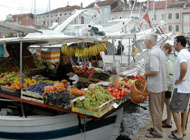 Shopping for produce on the island of Losinj, Croatia, is a colorful experience. 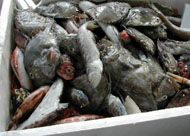
There's a wide selection of fresh fish at the public market on Losinj. 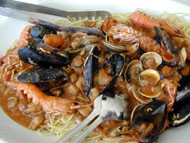
Spaghetti Fruitti diMare is one of the delightful dishes served at Restaurant Artatore on Losinj,Croatia. 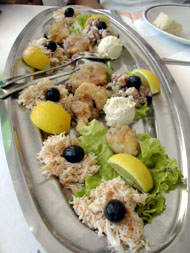
A cold antipasto platter, including crab and whipped white fish salads, is served at Restaurant Artatore. 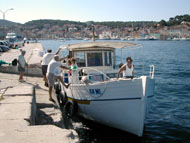
A group boards a boat for a trip to Restaurant Artatore on Losinj. 
Crostoli is a traditional birthday treat. Photos: NONIE FISH / for The Register-Guard |
It takes four flights to get from Eugene to Trieste, a mid-sized city at the northeast border of Italy and the closest jumping-off point to Losinj. The itinerary included our favorite small airline, Air Dolemite, with first-rate food service taking advantage of the best Italian specialties - an assortment of panini, breadsticks, prosciutto (ham), hunks of Parmesan and chocolate biscotti.
After landing in Trieste, we made a fast run through an Italian supermarket. We purchased olive oil, wine, saffron, San Danile prosciutto and a dinner to take along in the car.
The selections were overwhelming. We chose olive oil by color and region produced, and picked our wine - merlot, amarone, rubesco, sangiovese, pinot grigio,
pinot biancos, malvasia andtocai. Buoni! Olive oil and wine - the two most important elements of theItalian-Adriatic table.
For dinner in the car, wechose a little salami di felino, mortadella for my husband, olives and pecorino(sheep's cheese).
It was the first weekend of Ferragosto - the beginning of the Italian summer vacation. The roads were crowded with tourists, doubling the normal drive time between Trieste and Losinj.
Darko was an ultimate professional in navigating his cell phone as well as the rain-slickened roads, speaking in alternating Croatian, Italian and English on his phone and with his American passengers.
Eventually, we crossed intoCroatia, the sky black as midnight and producing a rainy torrent. At a ferrycrossing, where the plan was to switch cars at the other side, my son, Michael,slipped and dropped a bag of groceries. Fortunately, only a bottle of pinotgrigio was sacrificed.
The air was filled with the bouquet of diesel and vino. We dragged ourselves into the ferry's galley and sat grim-faced and punch-drunk. Once in a while, we broke into uproarious laughter.
As we arrived in Mali Losinj, all I wanted was a bowl of hot soup and a comfortable bed. We were met with hugs and kisses, and began catching up with one another.
Immediately, we became awareof luscious aromas from the kitchen - bowls of brodo (broth) with tiny stelline(star pasta).
We thanked God for our safearrival, and then slid our spoons into the brodo. The flavors of beef, chickenand grated Parmesan cheese bombarded me with happiness and the thoughts ofAntoinetta Pogliani. How incredibly lucky it was to cook with the 83-year old matriarch of the Pogliani family - our hosts.
The food is magnificent on this island. The basic ingredients have been blessed: fruit, vegetables, cheeses, seafood, poultry and meat are easy to come by at amazingly low prices.
Our days began at the breakfast table, where plans for the rest of the day were decided. We talked of picnics or hikes, discussed which beaches were best for swimming, debated eating outor in, and created the lists for the day's food shopping.
A double-birthday celebration (mine and Antoinetta's) included Restaurant Artatore, where the cold antipasto platter contained pesce in soar, a breaded fried white fish marinated in avinegar sauce. A salad of calamari and potatoes, shredded crab with its ownroe, was seasoned with lemon juice, olive oil and salt.
A warm seafood platter includedtender mussels, clams the size of little fingernails and scallops highlightedby the yolk-colored roe. On the bottom of the platter was a sea of nectarousbroth flavored with garlic. Pieces of bread held tightly by eager hands absorbedthe liquid.
These simple Italian seafood dishes served without grated Parmigiano is tradition at its finest. Not even World War II, when Mali Losinj was part of Italy, was cause enough to remove this enclave of Italians from the land that is now called Croatia.
Our birthday cake was an amazing rendition of a Genoise-like cake, a wonderfully moist sponge cake frosted with whipped cream that contained diced peaches and a hint of peach brandy. Candles were lit and the two mothers made wishes, and it was my honor to serve the cake. Buonissisma!
I will always remember myfirst taste of warming brodo, the grilled lamb, and pork sausages (cevapeici) served with coleslaw and red bell pepper puree, called Ajar. Red, white and blue Croatian flags waved off the bows of the boats. This is a part of the world unspoiled by tourism; but it won't be long before more people who love what these islands have to offer will visit this paradise.
Angnello con Erbe Di'Isola in Tecia
(Lamb with herbs
in a casserole)
Mrs. Pogliani prepared thisone evening. Tecia means "pot" in the Istrian dialect.
4 pounds lamb, cut into manageable size pieces, about a 1/2 pound apiece (use any pieces of lamb: leg, ribs, chops, etc.); You may have to use 2 saute pans
1 large head garlic, divided into cloves and peeled; cut half of them into matchsticks
6 sprigs (each about 4 incheslong) fresh rosemary, some of it with torn off stems, other kept long (donot use dried rosemary)
Olive oil
1 or 2 medium onions, cut into quarters
1 small bunch fresh sage (do not use dried sage)
4 to 6 fresh bay leaves (or 1 or 2 dried)
Salt and pepper to taste
1 1/2 cups dry white wine (or more if needed)
1 1/2 cups chicken broth (enough to keep lamb moist and keep meat from sticking to bottom of pot; Addmore broth if needed; don't let it stick)
Water
Cut slits into fleshy sections of lamb about 1 1/2 to 2 inches apart. First, stuff garlic into a slit and into the next slit, stuff rosemary.
Pour a small amount of oliveoil, just enough to cover bottom, into saute pans, about 1/8 inch. Laypieces of lamb in the pan, being careful not to have pieces touch. Scatter generously pieces of rosemary around the meat. Scatter rest of garlic cloves over meat if there are any left and as many pieces of onion that fit, not overdoing, maybe 4 pieces into each pan.
Scatter the sage and bay leaves into the pan. Salt and pepper meat. Brown on both sides on lively (medium-high)heat along with the onion sections. Carefully brown the thicker sections,as they will have more than one side, until all are golden brown, about 5to 7 minutes per piece of lamb.
When brown, add white wine and chicken broth to lamb and let boil for 30 seconds. Cover and put on low heat. As the wine and broth mixture cooks, it may boil away. Add water a littleat a time so meat will not stick.
Cook until meat is tender and comes away from the bone. Remove bay leaves and twigs from the herbs beforeserving. Serves 6.
Contorno di Patate e Sedano
(Side dish of celery root
and potatoes)
We had this dish to accompany the lamb.
2 heads celery root, peeled and each cut into 5 or 6 pieces
6 yellow potatoes (such as Yukon Gold, each about 3 inches long)
2 large-size carrots, peeled and cut into 2-inch size pieces
1/2 cube butter, sitting out of refrigerator to soften
About 1 cup warm milk
1/2 cup grated Parmigiano-Reggiano (Parmesan) cheese
Sprinkle of grated nutmeg (to taste)
Salt and pepper to taste
Cut up the vegetables and place in a large pot. Cover with water. Bring to boil, cover, turn down heat to low and cook until fork easily pierces vegetables. Drain, put through afood mill or food processor, add butter in pieces and mash together.
Add milk slowly, only as much as the mixture will take. Add cheese and nutmeg; incorporate. Salt and pepper to taste. Keep warm until ready to serve (can reheat in a microwave).
Croatian Pepperonata alla Lussignana
(Bell pepper mix)
For a salad, we had sliced tomatoes with the name Cuore di bue, or "heart of the bull." Heart shaped, they were served alongside the Pepperonata. This version is a room-temperature pepper and tomato spread.
3 large yellow bell peppers, chopped (or a combination of red, green or yellow bell peppers)
3 small eggplants, chopped
2 small zucchini, chopped
1 onion, diced
4 cloves garlic, chopped
3 to 4 tablespoons chopped fresh parsley
4 large tomatoes, chopped
Virgin olive oil to taste, plus extra
Salt and pepper to taste
Chop or dice the vegetables and parsley. Film a pan with olive oil, and cook vegetables in the oil over medium heat. Add salt and pepper to taste. Saute and mix occasionally. If the vegetables seem too dry as they cook, add a little water now and then. Cook on low heat until vegetables are softened almost like a spread. Mash together. Taste for salt and pepper and correct seasonings if necessary. Drizzlewith olive oil before serving at room temperature.
Sugo di Agnello (also called Sguazeto) alla Mrs. Pogliani
(Lamb sauce with spice)
Another recipe for using lamb was a sugo (sauce) and penne pasta. This is typical to the archipelago of Losinj. We sat around the table, inhaled the individual aroma and swooned as we ate bite after bite, hoping it would last.
Part 1:
1/4 cup to 1/3 cup extravirgin olive oil, depending on pan size
2 pounds leg of lamb, cut into 2-inch-by-3-inch pieces, with bones
1 1/2 large onions, thinly sliced
2 whole cloves garlic
1 small bunch sage
1 6-inch sprig rosemary
Film saute pan with olive oil. Dry pieces of meat with paper towels so they will brown well (if wet, they will steam and not brown). On medium heat, add onions and garlic; stir until each side has been covered with oils from pan.
Turn heat down and cover until onions wilt and lightly brown. Remove cover and put lamb into a pot. Make a bouquet garni from sage and rosemary (wrap in cheesecloth and tie witha string). Put into pot. Cover pan and let cook on a lively (medium-high) fire, watching closely by lifting the lid every 10 to 15 minutes, until tender enough to be pierced by a fork.
Then remove lid, stir and move around pieces that stick to the bottom of the pot. Cook and turn pieces of lamb an additional 12 to 15 minutes while the juices slowly evaporate andlamb pieces turn brown.
Part 2:
1 tube imported double-concentrate tomato paste
5 whole cloves
1 cup dry white wine
Salt
Black pepper to taste
1/4 teaspoon freshly groundnutmeg
1/4 to 1/2 teaspoons cinnamon (to taste)
1 pound penne pasta
1 cup grated Parmigiano-Reggiano (Parmesan) cheese
Combine the tube of tomato paste with 3 cups of water and 5 whole cloves and set aside.
Add dry white wine to lamb. Continue cooking on a lively (medium-high heat) fire and stir meat around in the pan until the wine evaporates. Pour tomato paste over meat and continue cooking for at least 45 minutes to an hour.
At this point, the liquid almost covers the meat. Sprinkle 1 heaping teaspoon of salt, black pepper to taste, freshly ground nutmeg and cinnamon into tomato paste mixture. Add more water if liquid evaporates too fast; but only a little at a time. Put cover back on, turn heat down to medium-low and cook 1 hour.
Check occasionally. (When the tomato sauce is done, it will have a light creamy consistency.)
At this point, if the lamb is not done, add more water slowly until lamb is cooked through and falls off from bones. Keep testing with a fork until the fork goes in easily, then check every 15 minutes or so, adding a little water when needed.
When lamb is done, remove from pot and set lamb aside for another meal.
Bring another pot of water to boil, add 1 or 2 teaspoons salt: Add the pasta and cook until al dente. When pasta is finished, drain, put back into pasta pot and pour warmed tomato sauce over pasta, correct for salt and pepper, toss with cheese and serve immediately.
Crostoli
A birthday tradition in the Pogliani family is a fried sweet, called crostoli, that is found in the region around Trieste. It is made each time a family member has a birthday. In English, we call them bowties or rags. Mrs. Pogliani took me into the kitchenone afternoon and began the crostoli lesson.
5 egg yolks
1 whole egg
1 tablesppon cooled melted butter
1 teaspoon sugar
1 pinch salt
2 tablespoon red wine vinegar
2 tablespoons rum
As much all-purpose flour as liquid absorbs to make a soft dough
Vegetable oil
Powdered sugar
Mix yolks, egg and melted butter, sugar, salt, red wine vinegar and rum together. Add a little flour at a time and with a fork mix slowly at first, incorporating flour, as much as the mixture will hold in order to make a soft, rollable dough. At this point, stop adding flour. Soon a ball will form. Let bowl sit covered 1/2 hour.
When ball can be handled, sprinkle flour onto a dry board, push extra aside so only a light coat remains on the board. Roll out into a 1/8 -inch thickness. Cut with a ruffled pastry wheel into ribbons 1-inch-by- 1/2 -inch long. Pull cut dough strips slightly lengthwise until you can tie each one into a single knot. Set each aside ona lightly floured cloth.
While working on dough, heat a pan large enough to hold crostoli 2 at a time with enough vegetable oil to come a third of the way up the side of pan (no more, the oil expands when heated and will overflow). Heat oil until a small piece of dough dropped into pan fries to a golden brown. Then put into pan 2 knotted pieces to deep fry to a golden brown (only 2 at a time). This probably takes about 1 minute. Take crostoli from oil with a slotted spoon and drain on paper from brown paper bags.
Continue to fry 2 at a timeuntil all are finished. Allow oil to cool while frying if it gets too hotand crostoli get too dark, then continue frying. If possible, oil may beused again.
Attractively pile the crostoli high on a platter and sift with powdered sugar. This is nice to serve for dessert with a sparkling wine such as proseco or a moscato d'Asti.
Brodo di Antoinetta
(Chicken and beef broth)
This is the welcoming broth we ate the night we arrived after our incredible 7 1/2 -hour trip from Trieste, through the pouring rain.
2 chicken legs
2 chicken thighs
1 piece beef shin - 3/4 to 1 pound (with bone, important because it gives broth more flavor)
2 large carrots
2 whole cloves garlic
1 whole onion, peeled and sliced, root end removed
1/4 peeled celery root or two stalks celery cut in half
Salt and pepper to taste
Pastina ( 1/4 cup per person), preferably little pasta stars
Grated Parmigiano-Reggiano (Parmesan) cheese to pass at table
Put all ingredients except pastina and grated cheese into an 8-quart stockpot, cover with cold water and bring to boil; keep at a gentle boil. When foam appears, skim and continue to skim until it is as clear as you can get it. Simmer broth on low heat for1 hour and 45 minutes to 2 hours.
Cool, remove chicken, beef and vegetables and set aside. You may use the items removed from the pot lateras a boiled dinner.
Continue to skim once more and try to get it as bright as possible. When ready to serve, remove as much broth as you will serve for dinner and put it in another pot. Set 2 cups orso aside into a small pot. Bring both broths to boil, check for salt and pepper,and correct seasons if necessary.
For each person you will be serving, put 1/4 cup of pastina into the broth. Cook until pastina is al dente (check by tasting). Check to see if there is enough broth in the pan or if the pastina has absorbed too much. If so, add some of the 2 cups of hot broth or as much as you think necessary to serve as a soup.
Check for salt and pepper. Serve and pass grated Parmigiano.
Pesche nel Biechiere
alla Walter
(Peaches in the style
of Walter)
One morning, we purchased six golden-skinned peaches - touched by a blush of rouge - to make a pie. But one thing led to another, and we were exhausted. Antoinetta's son, Walter, demonstrated a family specialty. Using the everyday white wine of the region, Malvasia Istriana, we sat around the table making our own individual desserts.
For one 8-ounce glass:
1 peach
2 to 3 teaspoons of sugar (or more if peaches are too tart)
1/2 to 3/4 cup dry whitewine (such as a pinot gris) to fill glass
Peel peach. Cut into bite-sized pieces. Dissolve 2 to 3 teaspoons of sugar into 1/2 to 3/4 cup of dry white wine. Put peaches into glass and pour white wine over them. Let stand about 30 minutes. Eat with a spoon and drink wine.
Insalata di Marisa
(Marisa's salad)
Another simple summer recipe - with what we called the taste of the island - came from a cousin of the Poglianis. Serve with a loaf of sliced, dense, crusty bread.
4 large tomatoes, hopefully 2 should be very ripe, cut into eighths
1/2 small red onion, slicedthinly
2 small crisp green cucumbers, skinned, seeded and cut into rounds
1/2 large or 1 small yellowbell pepper cut into matchstick pieces
4 to 5 tablespoons extra virgin olive oil
1 tablespoon robust red wine vinegar
Salt and pepper to taste
Combine vegetables in a bowl. In a separate bowl, combine olive oil, red wine vinegar and salt and pepper to make the dressing. Pour dressing over the vegetables. Toss and serve.All the juices in the bottom of the bowl that collect are for dipping withpieces of hearty bread.
Nonie Fish is a free-lance food writer from Eugene.
http://www.registerguard.com/news/2003/01/01/fd.croatia.0101.html